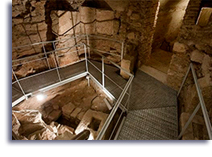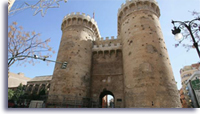Valencia is a city with many possibilities and that can be chosen based on personal preferences or the environment.
The Mediterranean climate is very pleasant almost all the year since, although the summer months are warm, the beach offers, at only 3 km. from the center of the city, beaches of golden sand and a sea of calm waters.
Naturally along the beach there are hotel and restaurant establishments to meet the needs or desires of those who come to this place.
The Huerta is a natural region whose capital is Valencia; It extends from North to South from Puzol to Catarroja and from East to West from the beaches to Manises.
A walk through the orchard is interesting because of the beauty of the crops, the palm trees and the option of seeing some of the increasingly rare homes typical of the farmers, the so-called “barracks“.
From the early days of the city of Valencia, there is a museum of archaeological remains, mainly Roman, behind the Basilica of the Virgen de los Desamparados; It is interesting and free, but it is advisable to book a visit.
In the city there are many interesting points; Following the route of bus number 5, you reach the two remaining gates of the walled enclosure, that of Quart, known as Torres de Cuarte, from the 15th century, the work of Pere Bofill and those of Serranos or Torres de Serranos, of late of the fourteenth century, by Pere Balaguer.
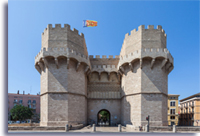
Both are fortified gates of the medieval wall of Valencia that still remain standing.
The walls disappeared as the population growth required, but there are some vestiges in isolated buildings.
Palace of the Generalitat
 It is located on Calle Caballeros and its small garden looks out onto the Plaza de la Virgen. It is a solid building with two towers; the architect was Pere Compte.
It is located on Calle Caballeros and its small garden looks out onto the Plaza de la Virgen. It is a solid building with two towers; the architect was Pere Compte.
The building is accessed through a beautiful Gothic courtyard. To the right, in the mezzanine of the tower, is the golden room, with a beautiful coffered ceiling; next to it, there is another smaller room, also coffered, although not gilded.
Going up the Gothic staircase, you access the floor where the Cortes Hall and the Kings Room are, with beautiful coffered ceilings and paintings with the Kings of Valencia and the members of the Cortes.
The visit is free.
It is located in the square of the same name and houses the image of the patron saint of the city who, although wearing the clothing she wears, does not look it but it is a carving from the 15th century.
Its structure is Gothic, although it was later covered, in part, by the Baroque decoration, but still retains very valuable elements of Gothic style: The Chapter Room, currently Chapel of the Holy Chalice, where this relic is located and whose walls are adorned by chains that closed the port of Marseille and that broke the ships of King Alfonso V the Magnanimous.
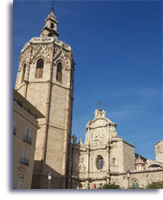 The tower of the cathedral, called the Miguelete, 50 m high, the same as the contour.
The tower of the cathedral, called the Miguelete, 50 m high, the same as the contour.
The double dome in the cruise with beautiful traceries.
The Cathedral has a museum where liturgical objects and paintings of interest are collected.
The doors were made in very different times; the oldest is Romanesque and is located on the side of the Archbishop’s Palace.
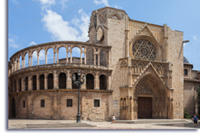 The one that faces the Plaza de la Virgen is Gothic and is called Puerta de los Apóstoles; in this door, on Thursday, the so-called “Court of the Waters” is celebrated, where the irrigation problems of the Valencian irrigation canals are solved, before the Reconquest.
The one that faces the Plaza de la Virgen is Gothic and is called Puerta de los Apóstoles; in this door, on Thursday, the so-called “Court of the Waters” is celebrated, where the irrigation problems of the Valencian irrigation canals are solved, before the Reconquest.
The main door is baroque and is small in relation to that of other cathedrals, because it faced a narrow street that disappeared along with the adjacent neighborhood of marble workers in the mid-twentieth century.
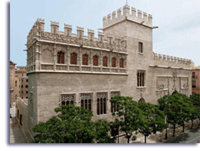 The Lonja and the Consulate of the Sea
The Lonja and the Consulate of the Sea
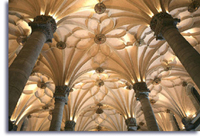 As a result of the commercial policy and the silk trade, this wonderful civil Gothic building emerged. It was erected at the end of the 15th century by Pere Compte and in addition to the doors and exterior decoration, it has a contract room, with three naves with 8 helical columns, ending in ribs, which resemble palm trees and support the roof.
As a result of the commercial policy and the silk trade, this wonderful civil Gothic building emerged. It was erected at the end of the 15th century by Pere Compte and in addition to the doors and exterior decoration, it has a contract room, with three naves with 8 helical columns, ending in ribs, which resemble palm trees and support the roof.
In the 16th century the Consulate of the Sea was added to it, where the Gothic style incorporates Renaissance elements.
The visit is free.
Central Market
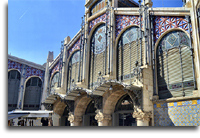 Opposite the Lonja, one of the most interesting markets, its spacious naves and the central dome make it the most important modernist building in Valencia. Its construction was completed in 1928. The architects of Barcelona Soler Marc and Guardia Vidal are responsible for the project.
Opposite the Lonja, one of the most interesting markets, its spacious naves and the central dome make it the most important modernist building in Valencia. Its construction was completed in 1928. The architects of Barcelona Soler Marc and Guardia Vidal are responsible for the project.
It is worth seeing it active, since it offers a wide range of products.
Palace of the Marqués de Dos Aguas
 The building is Rococo style, perhaps the most beautiful in Spain in this style, The cover made in alabaster by Ignacio Vergara, represents through two atlantes, pouring water, of two huge vessels, resting on their shoulders, the title of the Marquis, who ordered the construction of the palace.
The building is Rococo style, perhaps the most beautiful in Spain in this style, The cover made in alabaster by Ignacio Vergara, represents through two atlantes, pouring water, of two huge vessels, resting on their shoulders, the title of the Marquis, who ordered the construction of the palace.
Since 1954, the National Museum of Ceramics and Sumptuary Arts has been installed there, containing interesting collections not only Valencian, but also from the rest of Spain and some foreign pieces.
You can also admire furniture, decorative elements and even a beautiful float, which belonged to the Marquis owner of the palace.
Town Hall
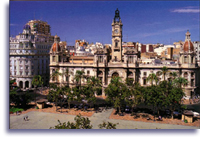 Located in the square of the same name, it is located in the place occupied by the former Casa de la Enseñanza and, after successive reforms and adjustments, acquired the current appearance in 1928, although later the main balcony of the facade was added.
Located in the square of the same name, it is located in the place occupied by the former Casa de la Enseñanza and, after successive reforms and adjustments, acquired the current appearance in 1928, although later the main balcony of the facade was added.
It has an interesting archive and library, containing valuable specimens, codices, such as the “Consulate of the Sea”, as well as historical elements, such as La Senyera, the city of Valencia, since it became part of the Christian kingdoms.
The assembly hall is of great beauty and both its interior where important paintings are kept, as well as outside, with sculptures by Beltran, Benlliure and Carmelo Vicent, make it interesting to visit it.
The visit is free.
The city, once the walls were demolished, has been growing and incorporating buildings from each era to the classics of the “ciutat vella” (old city).

